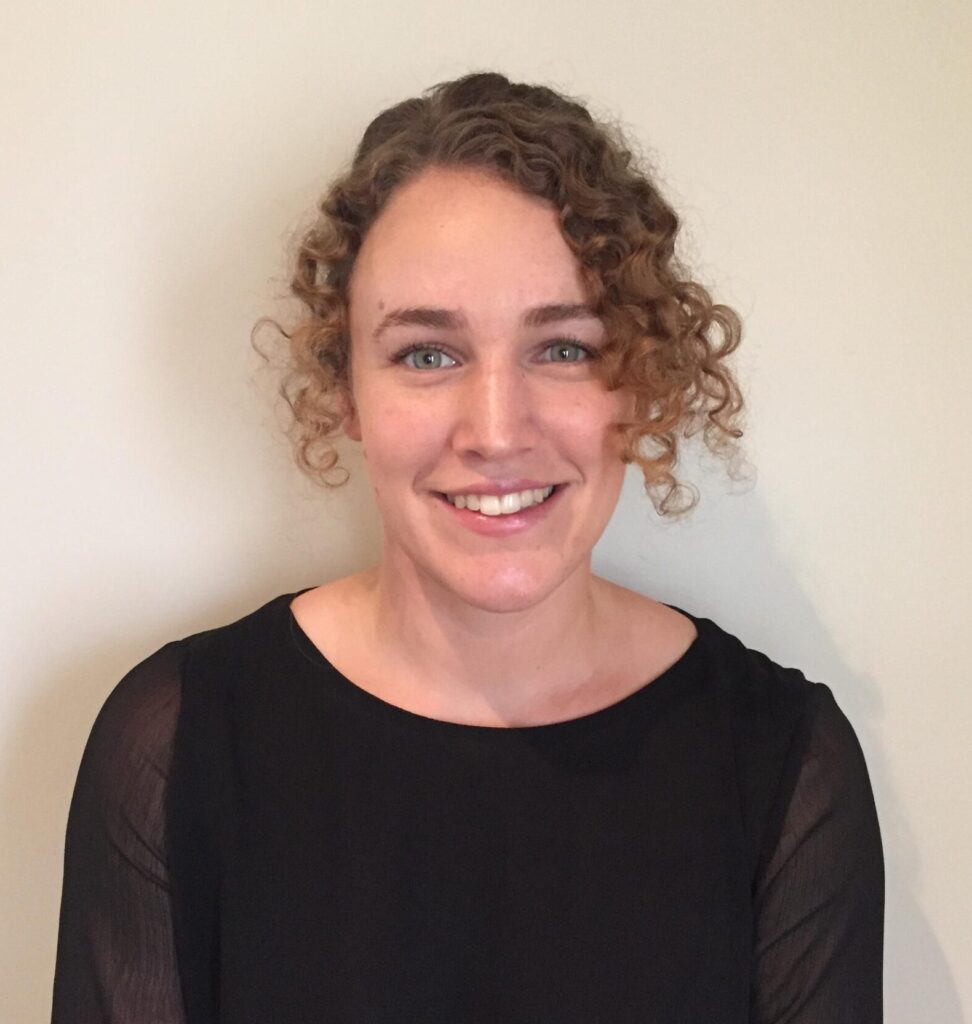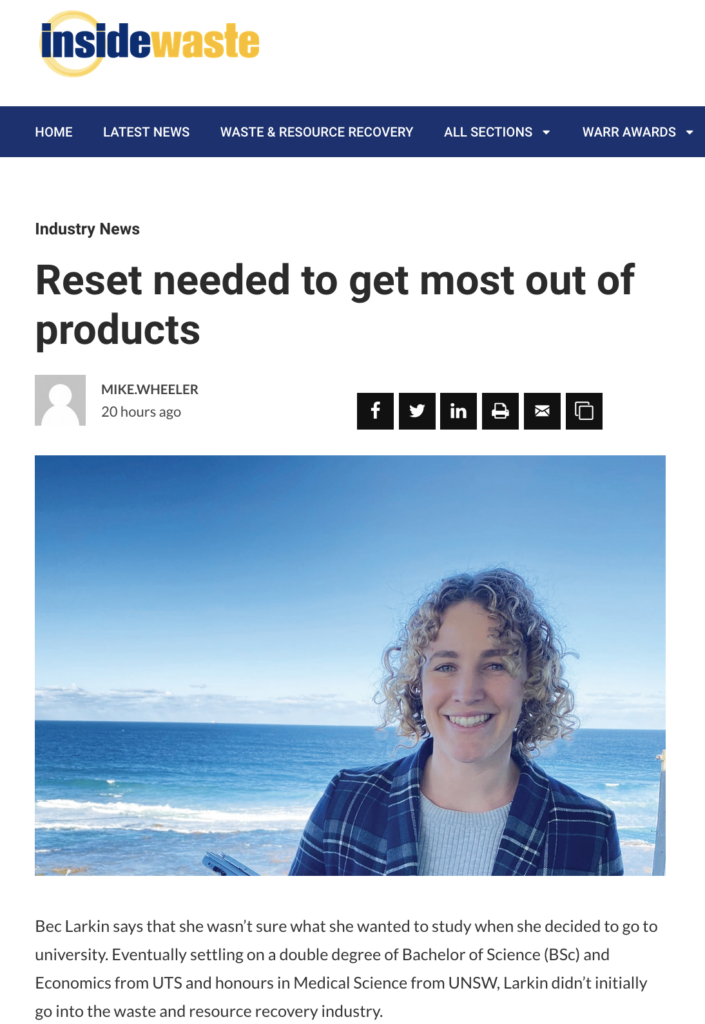Bec’s journey to the waste sector
Article on Inside Waste by Mike Wheeler

Bec Larkin says that she wasn’t sure what she wanted to study when she decided to go to university. Eventually settling on a double degree of Bachelor of Science (BSc) and Economics from UTS and honours in Medical Science from UNSW, Larkin didn’t initially go into the waste and resource recovery industry.
“I did my honours thesis on genome engineering and breast cancer,” she said. “I really liked it, then worked for two years as a research assistant in children’s cancer. After that, I decided medical research wasn’t for me; it didn’t come naturally to me – I couldn’t stop thinking about all the waste generated in the lab and thought it must be a similar story in every industry. I decided to take a year off and went travelling from Canada to Bolivia.”
And it was while she was in South America Larkin thought seriously about her next career move. While travelling around the continent, she could see a lot of waste issues. She decided that her ideal job would be to advise businesses how to manage their waste and materials – which she soon discovered was the perfect description of a waste consultant. After returning to Australia, she asked around a few friends and acquaintances. The name MRA Consulting popped up. She contacted the company in 2019 and was a waste auditor within a week. Not exactly the ideal job she had in mind, but she was excited to start somewhere.
“I was elbow deep in red bin rubbish for two weeks and sorting it into 50 categories,” she said. “It was disgusting – there were maggots, off chicken –I learnt I had a strong stomach.’
Interestingly, when asked what the worst thing she had found in a bin, her answer wasn’t what was expected.
“There was repulsive waste like food and nappies, but to me, the worst thing I saw were brand-new sneakers, still in the box,” she said. “I’m thinking, ‘Why are people throwing these out?’ Quality items are probably the most heartbreaking thing. It made me realise how big the disconnect was.”
Unsurprisingly, the sneakers were found in a very affluent suburb. That discovery opened her eyes to not only how wasteful people are but also the lack of understanding or valuing of what goes into manufacturing products and the globalised supply chain.
After being an auditor, Larkin’s became an environmental consultant in the strategy and commercial team at MRA for several years. More recently, she moved into the circular economy team and became a senior consultant.
“In the strategy and commercial team, I was able to build such a solid base of skills and knowledge through detailed research projects and feasibility studies, as well as developing waste strategies and understanding the role of Government. All the projects were varied – from researching industry specifications for glass, plastic and tyres for the waste export bans, to designing a product stewardship scheme and developing a sustainably packaging strategy for a food production company. I found myself naturally gravitating to projects that considered more than just recycling or landfilling, solutions; that looked at upstream interventions and trying to avoid waste in the first place. What’s the point of tackling waste if you’re not tackling the volume of materials going into the system? So, I made the move into the circular economy team. Among other things, we are interested in finding opportunities to replace single-use items with reusable options and understanding what are the impacts of a reusable system on the existing business model and what are the barriers to making this happen.”
A lot of the work involves re-thinking the current system and putting better procedures in place. For example, a business might have a supply chain producing a certain item. Larkin and the circular economy team will go in and look at better ways to streamline the process, minimise waste and also emissions along the pathway. Businesses have the opportunity to make a huge impact but there is a lot to consider, and we’d like to help them map out the steps.
“I’m currently working on a project looking at circular interventions for plastics in hospitals – it’s a massive task in a very complex ecosystem. It sort of feels like I’ve come full circle since working in the lab and thinking of all the plastic going to clinical waste – I haven’t found the solution but I’m working towards it.”
Larkin finds that most companies she works with are fully engaged in trying to get rid of their waste in a timely and proper manner. Although there are government targets – such as those set by APCO around packaging – there is also the social license aspect of the circular economy. Customers want to ensure that companies are doing the right thing so companies are holding themselves accountable.
And if Larkin ruled the world, what would she like to change? Our reliance on recycling, she said. What? Isn’t that what most of us are trying to do? Recycle stuff so it doesn’t go to landfill? Sure, but Larkin wants to go that one step further. How about designing products so that the ‘waste’ can be designed out? She said that, currently when a product is produced, if the designers think about the end of life, they think about what waste stream something should go in. They should be going back a step.
“There are some circular elements to recycling, but businesses can redesign the system at the beginning. That way, they can design out the waste at that first stage,” she said. “It’s all about the whole supply chain and looking at how every decision should be considered, such as the product’s end of life. It needs to be considered at every point along the way. Maybe a reusable element can be incorporated into the supply chain. I recently completed a course on sustainability in the fashion industry. It was incredibly eye-opening – and depressing – but also uplifting.”
Why? Because, on the one hand, it is a very consumption-focused industry where companies’ business models rely on the public to ‘buy, buy, buy’. However, she also saw elements within that industry who were taking a more holistic approach to making products that were sustainable, even if it was costing them part of their profits.
“The textiles space is something that I’m really interested in and so are clients,” she said. “We recently held a regional Think Tank event on textiles circularity to develop tangible action plans and pilots to combat textile waste. And we have previously worked with charitable organisations to quantify the impact of the textile reuse sector. I love utilising data to paint a picture for people to see the extent of the problem so that they feel motivated to take action. It also adds robustness to interventions.”
Her final wish is that messaging surrounding extending the life of products also needs to be amplified loud and clear to the consumers.
“The impacts of products on the Earth can be minimised by consumers extending a product’s life,” said Larkin. “It all comes down to impact. You can buy a cheap piece of clothing. If you wear it 50 times, the negative carbon material inputs can be offset if you keep wearing it or keep using it and don’t throw it out. Yes, the producers have the responsibility to source sustainable and ethically sourced material, but the consumer has the responsibility to get the most use out of it and value it so that it doesn’t just end up in landfill.”
This article has been published by the following media outlets:




